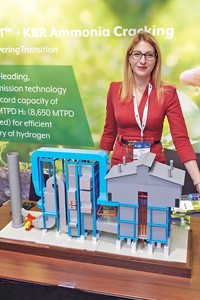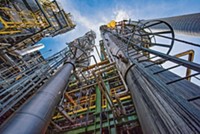Advertisement
Grab your lab coat. Let's get started
Welcome!
Welcome!
Create an account below to get 6 C&EN articles per month, receive newsletters and more - all free.
It seems this is your first time logging in online. Please enter the following information to continue.
As an ACS member you automatically get access to this site. All we need is few more details to create your reading experience.
Not you? Sign in with a different account.
Not you? Sign in with a different account.
ERROR 1
ERROR 1
ERROR 2
ERROR 2
ERROR 2
ERROR 2
ERROR 2
Password and Confirm password must match.
If you have an ACS member number, please enter it here so we can link this account to your membership. (optional)
ERROR 2
ACS values your privacy. By submitting your information, you are gaining access to C&EN and subscribing to our weekly newsletter. We use the information you provide to make your reading experience better, and we will never sell your data to third party members.
Energy
Can FuelCell Energy’s molten carbonate fuel cell help solve the CO₂ problem?
Company says its next-generation fuel cell can get gas and coal power plants close to green
by Craig Bettenhausen
March 27, 2021
| A version of this story appeared in
Volume 99, Issue 11

Carbon capture looms large in many oil and chemical companies’ plans to reduce greenhouse gas emissions. It has to. Converting hydrocarbons to carbon dioxide and water frees the heat that drives most industrial chemical reactions and spins most electricity-generating turbines. And historically, the way to do that conversion has been to set the hydrocarbons on fire.
But capturing the CO2 vented from such combustion is difficult because it’s so dilute. The mixture of gases coming out of most combustion chambers is 8–15% CO2 by volume. The CO2 needs to be close to pure to work economically in storage or utilization schemes.
The most mature technology for capturing carbon during power generation passes flue gas through an amine solution that absorbs CO2. Heating the saturated solution releases the CO2 at a workable concentration. But that approach comes with a heavy energy cost—around 17% of a power plant’s output.
FuelCell Energy (FCE) is offering an alternative. The Connecticut-based firm has developed a new type of fuel cell that uses molten carbonate electrolytes. This electrochemical cell can capture CO2 from a power plant’s flue gas while generating additional electricity from natural gas, coal, or other fuels. The company has more than 100 US fuel-cell patents, big-name partners, and a soaring stock price. What it doesn’t have yet are profits or a marquee project that shows its technology pays off at commercial scale.
FCE has been around for 52 years. It spent many of its early days working on batteries before spinning that division off to focus on fuel cells in 1999. The firm and its customers operate 50 molten carbonate fuel cell (MCFC) power plants that provide on-site electricity and steam or hot water. Most of the installations are in the northeastern US and California, along with several in South Korea and the European Union.
FCE’s fuel cells have always been able to capture their own carbon because the fuel doesn’t directly mix with air. Using MCFCs to capture other CO2 is an idea that is getting increased interest from operators of power plants and boilers.
Not surprisingly, FCE’s focus right now is on commercializing its carbon-capture technology, CEO Jason Few says. It’s also working on a reversible solid-oxide fuel cell that can consume hydrogen to produce electricity or turn around and consume electricity to produce hydrogen.

Fuel cells of all types are attractive because they convert chemical energy into electrical power through controlled electrochemical reactions instead of messy combustion. Most commercial fuel cells run on hydrogen and emit water vapor, not CO2. But most hydrogen is generated industrially from methane by energy-hogging steam reformation and water-gas shift reactions that release CO2.
FCE’s MCFC differs from conventional cells in two crucial ways.
First, it can convert hydrocarbons to H2 internally, using the water and waste heat generated by the cell. Its nickel electrode can catalyze reformation and gas shift reactions at the 600 °C operating temperature inside. Because the H2 is continuously consumed right there, Le Chatelier’s principle pushes both reactions to completion. FCE’s chief technology officer, Tony Leo, says the cell can even consume alcohols as fuel, though the power plants currently in place run on methane or biogas.
Second, the cell pumps CO2 through the electrolyte as part of its electrochemical cycle, carrying it from the N2-diluted air stream to the concentrated fuel stream. Stand-alone MCFCs have to recycle some CO2 back to the air inlet to keep that cycle going. However, MCFCs attached to the end of a power plant can pull around 90% of the CO2 out of the flue gas.
Crucially for carbon capture, the gas flowing out of an MCFC is around 70% CO2 along with H2O and some extra H2. And it’s much easier to separate CO2 from water than from the nitrogen that makes up around 70% of industrial flue gas.
FCE engineers have optimized the system to work with coal-fired power plant flue gas, Leo says, and they’re working on the right parameters for natural gas power plants through a partnership with ExxonMobil. The firms have been working together on MCFCs and carbon capture since 2016 and signed a 2-year extension of that arrangement worth $60 million in November 2019.
The additional output of H2 and water were key selling points for Toyota when it was looking to install a fueling station for hydrogen-powered cars in Long Beach, California. An MCFC scheduled to come on line there later this year will provide fresh water, 2.3 MW of electricity, and 1,200 kg of H2 per day to fill Toyota’s fuel-cell engines. It will be FCE’s first commercial-scale plant with that configuration, which the firm calls trigeneration.
If fuel cells are so great, why does FCE promote adding them to polluting power plants instead of using them to replace the old technology outright? In some places, fuel cells are in fact going in where conventional gas turbines might have otherwise. But tax credits, cleantech mandates, or other government incentives are usually needed to overcome the capital cost advantage that conventional plants enjoy, according to a 2019 analysis published by the International Energy Agency (IEA).
And some industries, including chemical manufacturing, require steam and heat. “There are certain things you’re just not going to get done with wind and solar,” Few says. “You’re going to still need other forms of energy.”
Carbon capture has the potential to maintain the productivity of the existing energy infrastructure even as consumers and regulators demand fewer greenhouse gas emissions. In the case of a 500 MW conventional power plant, Leo says, “We could just turn it off and replace it with a 500 MW carbonate fuel cell that captures its own CO2. But it’s probably cheaper to leave that equipment in place and add a 150 MW carbonate system.”
The IEA report modeled a 550 MW coal-fired power plant fitted with FCE’s carbon-capturing MCFC running on a separate stream of natural gas. The fuel cell in that model captured 90% of the coal plant’s CO2 emissions while putting out 351 MW of additional power.
When you factor in the additional power, FCE’s carbon-capture method would cost 60% less than an amine-based approach on the same flue gas in the IEA’s model. The cost of CO2 captured would be $33.63 per metric ton, according to the report, lower than the US Department of Energy’s target of $40 per metric ton. Pilots run with ExxonMobil and the DOE got comparable results, Few says.
Promising numbers from models and pilot installations, along with what many hope to be a better political environment for carbon capture, are generating investor interest in FCE. The firm’s stock rose from around $2.50 in November 2020 to a high of around $28 in February. It has slipped since then and has been hovering around $17 for most of March.
Stock analysts seem to think that at least some of the rise in stock price is merited. Jeffrey Osborne, an analyst who covers FCE for Cowen, set a price target for the stock of $15.50 in late January, citing the partnerships with Toyota and ExxonMobil and good prospects for new installations in Europe, North America, and Asia.
In December, Canaccord Genuity analyst Jed Dorsheimer wrote that “we see great potential but recognize the lumpiness in near to midterm results that is likely to increase volatility” as FCE commercializes its carbon-capture technology and its reversible hydrogen fuel cell. Canaccord’s price target for FCE was $8.80.
FCE has taken some lumps. In September, it won bids to install four 2.8 MW MCFC power plants around its home state of Connecticut. Then in December, the state reversed course, pulling three of those awards and giving them to solar projects instead. Few, the CEO, has enlisted several state and local lawmakers in an effort to restore the projects. And in South Korea, an agreement with Posco Energy to distribute FCE’s technology in the country fell apart in early 2020.
FCE posted a loss of $17.7 million in 2020 on $70.9 million in revenue. It was an improvement from a loss of $31.4 million in 2019 but a loss nonetheless.
Few, who took over as CEO in August 2019, characterizes FCE today as a firm in the late stages of converting from an R&D company to one making, selling, and servicing commercial products. “We think that there’s going to continue to be tremendous pressure to do things around carbon capture,” he says, “and we think we’re going to have a very compelling solution for that.”




Join the conversation
Contact the reporter
Submit a Letter to the Editor for publication
Engage with us on Twitter